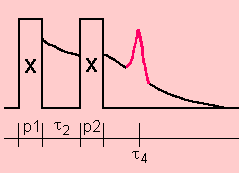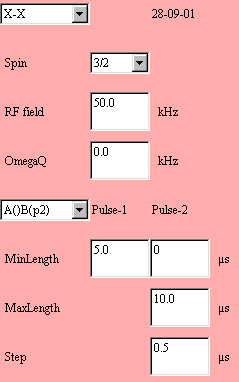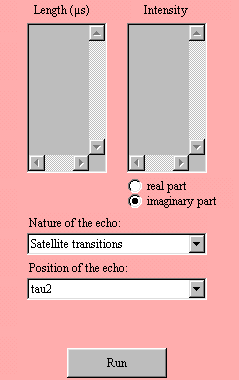AIM: Determination of the quadrupole coupling from a featureless NMR lineshape
Launch the Solomon echo applet with Java Web Start.

In order to detect Solomon echoes, the duration tau2 between the two pulses must be shorter than the duration of the free-induction decay (FID) of the central transition. Solomon echoes are satellite-transition signals superimposed on the FID of the central transition following the second pulse. Single-quantum (SQ) transitions between consecutive energy levels as well as multi-quantum (MQ) transitions between non-consecutive energy levels occur during the excitation of the spin system by the first pulse. SQ and MQ coherences generated by this pulse are converted back to -1Q coherences as echoes of satellite transitions by the second pulse. Solomon echoes are observed in the two channels of the receiver. The observation of these echoes requires the optimization of the two pulse-lengths p1 and p2.

The echo amplitudes in this experiment are a product of two functions: the excitation function A(p1) that depends on p1 and the conversion function B(p2) that depends on p2. In fact, A(p1) is a sum of four coherences generated by the first pulse.
The left part of the simulation panel indicates the physical parameters. It is preset for a typical experiment on a spin I = 3/2. You can introduce your own values.
First, we select the pulse sequence with the choice box:
(1) X-X means a two in-phase pulse sequence;
(2) Y-X means two pulses in quadrature phase.
Then, we select with the lower choice box one of the two types of
calculation:
(1) A(p1)B(): the echo amplitude with p1 variable and
p2 constant;
(2) A()B(p2): the echo amplitude with p1 constant and
p2 variable.
When a pulse length is constant, it should be provided in the MinLength field.
MinLength: the first variable pulse-length in µs
MaxLength: the last variable pulse-length in µs
Step: the increment of the variable pulse-length in µs
Finally, we select the nature of the echo and its position with the two choice boxes above the RUN button. Since echoes are detected in the two channels in quadrature of the receiver, after pressing the RUN button we use the check buttons to choose the real or the imaginary parts of the echo amplitude.

The following applet is initialized for the satellite echo amplitude A()B(p1) of a spin I = 3/2 in a single crystal excited by the X-X sequence; this echo is located at tau4 = tau2; the pulse length p1 is equal to 5 µs and p2 increases from 0 to 10 µs by 0.5 µs step. The experimental line intensities are identical to the simulated ones.
Help for selecting all the simulated data of the line intensity text area in a JDK1.1.8 applet.
